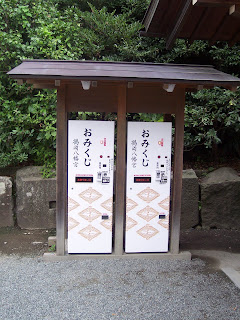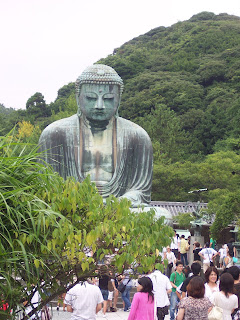My one-man trip was really awesome! I've never enjoyed America's legendary "country hospitality" and so this trip in Japan showed me by analogy just what I've been missing by holing up in a city for the past few years.
The LodgingI wanted to put edible things first, but for those of you who are similarly stomach-driven, my waiting will encourage you to actually read this part.
I stayed at two ryokan (Japanese-style, futon pad on bamboo rattan mat [tatami] floor inns) and one youth hostel inside a Buddhist temple. One thing I was initially concerned about was the adjustment to tatami sleeping--wouldn't it be painful on the back and harder to sleep comfortably? Thankfully, I was completely wrong; my body loved the mat more than a Western-style mattress!

This is what the rooms typically look like, with bedding in the center of the single room and a little sitting table with tea utensils inside the circular box. All the bedding is stored inside deep cupboards which are covered with sliding wall panels, making it easy to use the room for a multitude of purposes. This multi-purpose ingenuity comes from the time when ancient aristocratic houses used to have all rooms with tatami.
The youth hostel had the same flooring but multiple dudes to a room and common sit-down areas instead of an in-room table. Here's the entrance, and if you look closely you can see the "JYH" sign above the door. Those windows on either side of the main door are styled after the lotus flower, which

to many Buddhists is not only a metaphor of pure mind rising above the murk of worldly illusion but also the chair that devout followers will perch on in the afterlife.
The FoodOK, OK, I give in. Matsumoto, my first stop, is famous for oyaki [dim sum-style buns stuffed with regional veggies], basashi [horse sashimi], and inago [crickets coated in a sugary glaze]. The middle one was expensive and the first one a roadside snack, but I couldn't resist the chance to tell people I'd munched on crickets. (There's my pride, I confess.) So I headed off in search of the elusive insect treat, and

ended up being let into a closed restaurant by a kindly woman--here's that hospitality--who served me not only crickets but some kind of insect larvae with the same preparation. I didn't ask too many questions and can report that while the taste is a little too cloyingly sweet to be eaten alone, crickets have an excellent texture. Yes, I will return if the Lord wills to this town so I can order a proper meal at this restaurant...it's called reciprocity.
Takayama, my ending destination on the other side of Mountain Peak National Park (also known as the "Japanese Alps"), is famous for its miso [salted soybean paste] grilled with mountain vegetables on a magnolia leaf, but I went for something a bit heartier: a stew of the same mixture with chicken and dumplings. It was delicious!

Miso takes some getting used to, but it's an excellent source of vegan protein and very versatile (apparently used instead of butter or salt on Japanese corn-on-the-cob). And this stew, like almost every BBQ or pot-based dish over here, was served on a tabletop stove to ensure that it finished cooking right in front of you.
I know school is just getting into gear for everybody now, so rest assured that I'll only torment you with one or two more entries on my freedom, which ends Monday.
 So we did just that. The bag has wrapped presents of candy for each boy and girl; the only two catches were that I offered a male present to someone of the female sex with a particularly short haircut and that there were too many gifts for the boys, leaving the staff to fix the imbalance as I left.
So we did just that. The bag has wrapped presents of candy for each boy and girl; the only two catches were that I offered a male present to someone of the female sex with a particularly short haircut and that there were too many gifts for the boys, leaving the staff to fix the imbalance as I left. One fun little thing was practicing culturally proper sitting posture (see "Content..." from August, 5th paragraph) while in costume. They also offered green tea, as is customary when serving any visitor to an institution, and I plan on recommending that my toy workshop be retrofitted with tatami flooring once the blue-collar elves get their act together after New Year's.
One fun little thing was practicing culturally proper sitting posture (see "Content..." from August, 5th paragraph) while in costume. They also offered green tea, as is customary when serving any visitor to an institution, and I plan on recommending that my toy workshop be retrofitted with tatami flooring once the blue-collar elves get their act together after New Year's.
















































